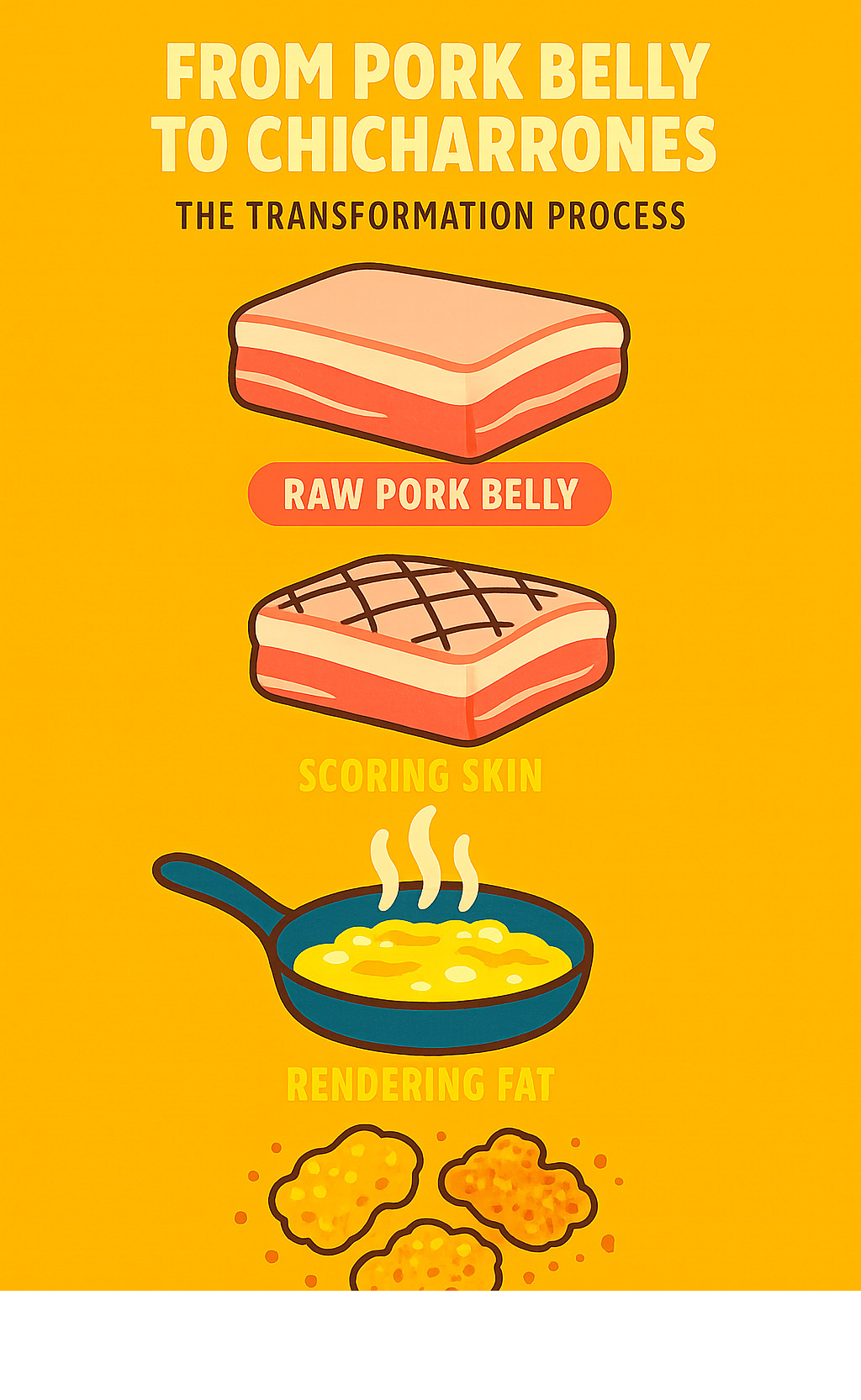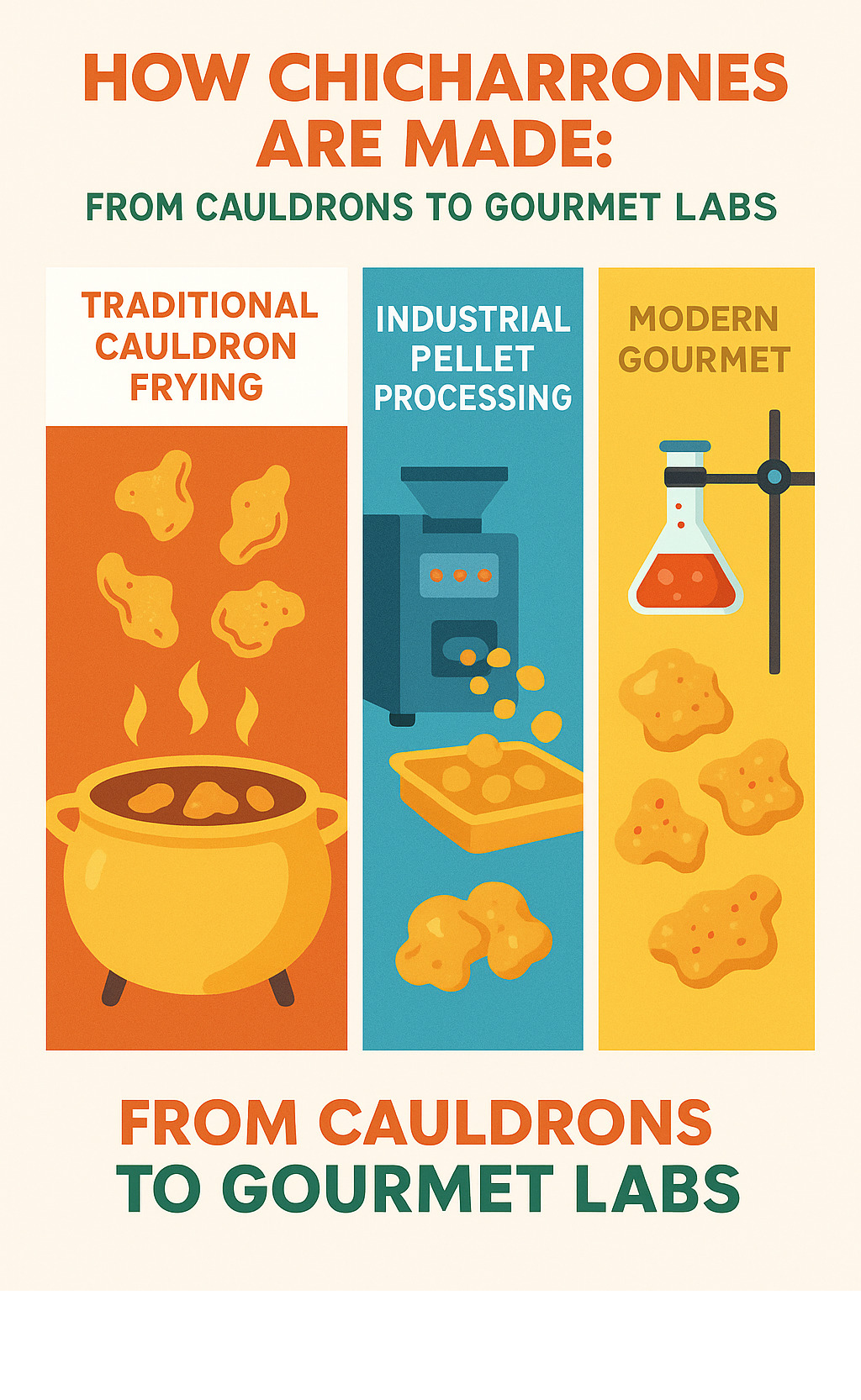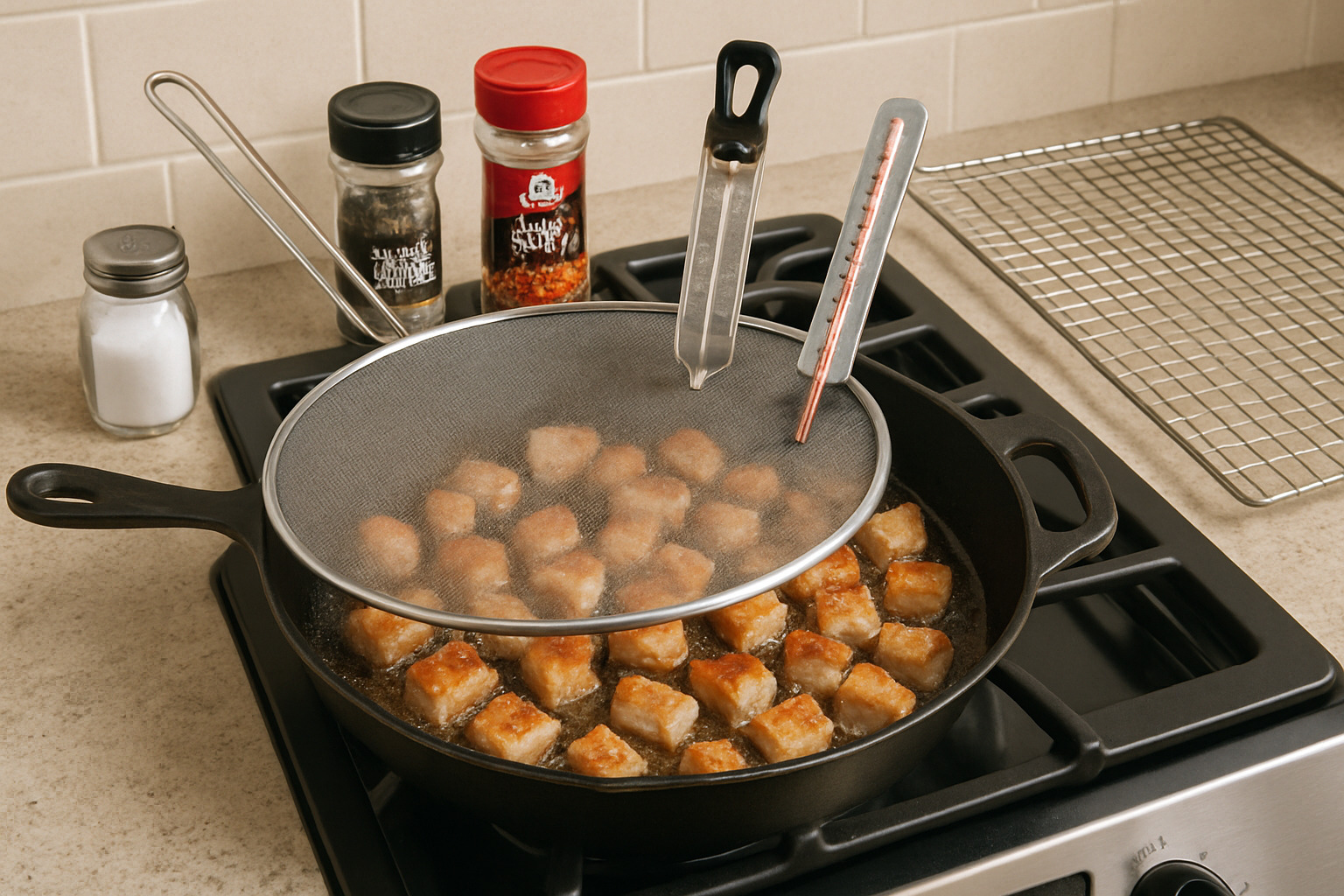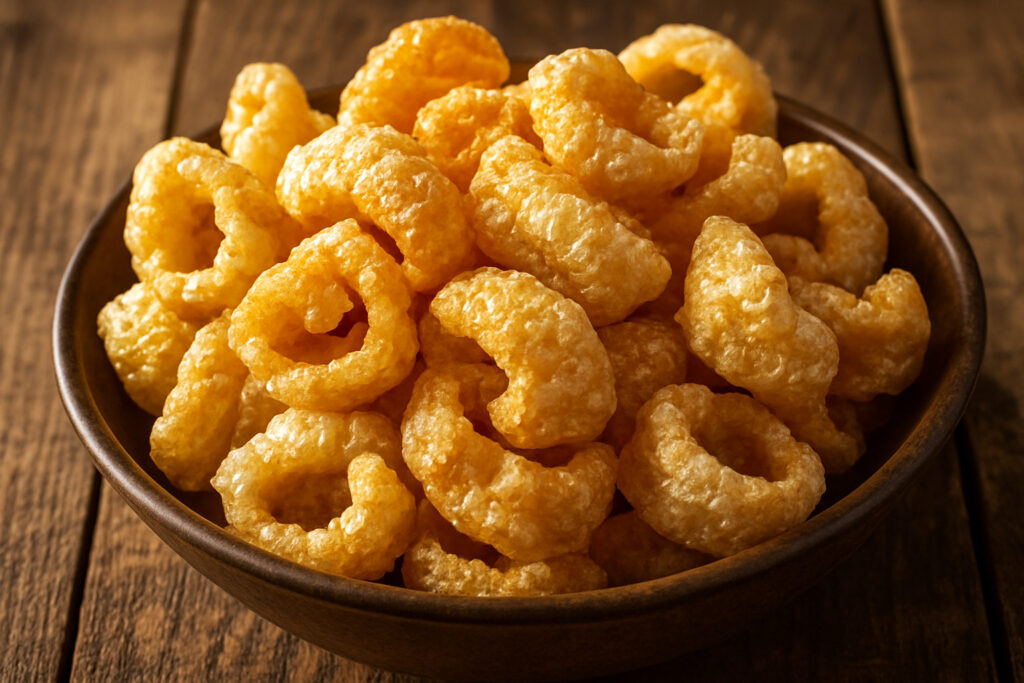What Makes Chicharrones the World’s Most Beloved Crispy Snack
Chicharrones are fried pork belly or pork rinds that have captured hearts and taste buds across the globe. From Mexican street corners to Filipino bars, these golden, crispy morsels deliver an irresistible crunch that food lovers can’t resist.
Quick Facts About Chicharrones:
- Origin: Spain, spread worldwide through colonization
- Main ingredient: Pork belly or pork skin
- Cooking method: Rendered in their own fat, then fried until crispy
- Texture: Crunchy exterior with tender, fatty interior
- Popular in: 20+ countries including Mexico, Philippines, Colombia, Peru, and the Southern United States
- Serving style: Snack with lime and salsa, or ingredient in dishes like tacos and mofongo
Whether you call them chicharrones, pork rinds, or cracklings, these crispy treats represent one of the world’s most successful culinary exports. The basic concept is simple: take pork skin or belly, render the fat slowly, then fry until it puffs into golden perfection.
But here’s what makes chicharrones fascinating for food travelers – every country does them differently. Mexican vendors serve massive sheets you break apart by hand. Filipino cooks turn them into pulutan (bar snacks) with vinegar dips. Peruvians stuff them into breakfast sandwiches.
The magic happens during a two-stage cooking process that transforms tough pork skin into airy, crunchy bites. Traditional methods involve simmering the pork until water evaporates, then frying in the rendered fat until golden.

What Are Chicharrones?
The word chicharrones rolls off the tongue like a promise of crispy goodness, and it delivers every time. This Spanish term describes what happens when you take pork belly or pork rinds and transform them through the magic of slow cooking and high-heat frying.
The Spanish perfected this technique centuries ago in Andalusia, then carried it across oceans during colonial times. What started as a practical way to use every part of the pig became a beloved chicharrón tradition that spans continents.
The real magic happens during cooking. You start with tough pork skin, then slowly render out the fat until that same fat becomes the cooking medium. When you fry the skin in its own rendered fat at just the right temperature, it puffs up like little golden pillows.
Chicharrones vs Pork Rinds vs Cracklings
Walk into different regions and you’ll hear different names for what looks like the same crispy treat. But there are real differences worth knowing about.
Pork rinds are the lightweight champions of the crispy snack world. They’re made from pure skin with all the fat and meat removed. Most commercial versions start as dehydrated pellets that balloon up when hit with hot oil.
Cracklings bring more substance to the party. They include the skin plus a good layer of fat and often some meat too. They’re denser and more filling than pure pork rinds.
Chicharrones can be either style, depending on where you find them. Mexican street vendors often offer both chicharrón delgado (the thin, airy type) and chicharrón gordito (thick cuts with meat and fat).
Beyond Pork: Other “Chicharrones”
Creative cooks never met a rule they couldn’t bend, and chicharrones are no exception. While pork remains the star, amazing variations prove this technique works with other ingredients too.
Chicken skin chicharrones are crispy revelations. Mexican home cooks have been making these for generations, saving chicken skins and frying them until golden and crunchy.
Fish skin chicharrones might sound unusual, but they’re absolutely delicious. Filipino cooks make amazing versions using tuna skin.
The most surprising twist? Vegetarian chicharrones made from wheat and corn. These duros puff up just like the real thing when dropped in hot oil, complete with chile and lime seasonings.
Origins and Global Variations
The story of chicharrones begins in medieval Spain, specifically in Andalusia and the Canary Islands. Spanish colonizers brought their pork-frying techniques to the Americas, where local ingredients and cooking traditions created entirely new variations.
What makes chicharrones fascinating is how they’ve become a truly global street food. Before refrigeration existed, rendering pork fat and frying the skin created a shelf-stable, protein-rich food that could last for days.
For more insights into how street foods like chicharrones spread globally, check out our comprehensive guide on Street Food Diaries: A Bite-by-Bite Journey Around the Globe.
Latin American Classics
In Mexico, chicharrones are serious business. Vendors at tianguis markets fry massive sheets of pork skin in enormous cazos (metal pots), selling them by weight. The fresh chicharrón gets broken into chunks for tacos, mixed with salsa verde, or simply eaten with lime and hot sauce.
Peru takes a different approach, using country-style pork ribs without skin. They boil the meat until dry, then fry it in rendered fat. The result goes into breakfast sandwiches or gets served as an appetizer.
Colombia incorporates chicharrones into their famous bandeja paisa, while Puerto Rico has made them essential to mofongo preparation.
Here’s a fun fact: Bayamón, Puerto Rico is actually nicknamed the “City of Chicharrón.”
Asian & European Adaptations of Chicharrones
The Philippines developed their own chicharrón tradition perfectly suited to their drinking culture. They serve it as pulutan (bar snacks) alongside alcoholic drinks, often with vinegar-based dipping sauces.
In Serbia, čvarci represents a similar concept – rendered pork fat and skin fried until crispy. Quebec has perhaps the most colorfully named version: oreilles de crisse (literally “Christ’s ears”), served as palate cleansers in sugar shacks.
Uruguay has developed maybe the most unusual variation – they make chicharrones from cow kidney fat as a byproduct of tallow production, then use them as bread additives.
How Chicharrones Are Made: From Cauldrons to Gourmet Labs
There’s something magical about watching a skilled vendor transform tough pork skin into golden, crispy chicharrones. The traditional render-then-fry technique has remained virtually unchanged for centuries.
The process starts with patience. First, you slowly cook the pork until its fat renders out completely. Then comes the change – frying those same pieces in their own rendered fat until they puff up like edible balloons.

Many contemporary recipes call for baking soda as a secret weapon. Rubbing pork skin with this common kitchen ingredient creates an alkaline environment that speeds up browning reactions and helps remove moisture faster.
Traditional Mexican vendors swear by repurposed tractor disc blades called “disco pans” for their frying. Meanwhile, industrial producers have turned chicharrones production into precise science, dehydrating pork skin into pellets that puff perfectly when hit with 400°F oil.
Step-by-Step Traditional Technique
The authentic method follows a rhythm that can’t be rushed. It starts with preparation – cutting pork belly into manageable strips and scoring the skin.
Next comes the curing stage. Rubbing the pieces with baking soda and salt, then letting them rest uncovered in the refrigerator for at least two hours.
The parboiling phase involves simmering the pork in water with aromatics like garlic and bay leaves for about an hour, until all the water evaporates.
As the water disappears, the rendering begins. The pork starts cooking in its own fat, which slowly bubbles out.
Finally comes the frying finale. Increase the heat and let those pieces fry in their rendered fat until they turn golden brown and puff up beautifully.
Commercial vs Homemade vs Gourmet
Commercial chicharrones prioritize convenience over complexity. These light, puffy snacks come ready-to-eat but sacrifice the deep, rich flavors that come from slow traditional cooking.
Homemade versions require a serious time investment, typically 2 to 4 hours from start to finish. But the payoff is incredible – dense, meaty textures with complex flavors.
Gourmet chicharrones offer the best of both worlds. Artisanal producers use quality ingredients and traditional techniques while experimenting with exciting flavor combinations like hot honey glazes and truffle salt seasonings.
Seasonings & Serving Customs
Traditional seasonings keep things beautifully simple – salt, lime juice, and maybe some chile powder. Peruvians serve their chicharrones alongside spicy ají sauces. Colombians pair them with hogao, a savory tomato-onion sauce.
Beer pairings seem almost universal wherever chicharrones are popular. The salty, fatty richness creates the perfect contrast to cold beer’s crisp bitterness.
For more inspiration on where to enjoy these perfect chicharrones and beer combinations, explore our guide to interesting places to eat around the world.
Nutrition, Health and Modern Dietary Spins
Let’s be honest – chicharrones aren’t exactly what your doctor ordered. A typical serving packs around 1,175 calories with 120 grams of fat and 21 grams of protein.
But here’s where the nutrition story gets interesting. These crispy treats are essentially pure protein and fat with zero carbohydrates, making them surprisingly compatible with ketogenic and paleo diets. The high protein content delivers all the essential amino acids your body needs.
The saturated fat debate has gotten more nuanced lately too. Recent scientific research on saturated fat suggests the relationship between saturated fat and heart disease isn’t as cut-and-dried as we once thought.
What does deserve attention is the sodium content. Commercial versions can pack 25-30% of your daily recommended sodium intake in a single serving.
Are Chicharrones Healthy?
The answer really depends on how you define “healthy” and what the rest of your diet looks like. Chicharrones do offer some legitimate nutritional benefits.
The high-quality protein contains all essential amino acids, while the pork skin provides collagen that supports joint and skin health. The zero-carb profile makes them a perfect fit for low-carb diets.
On the flip side, the caloric density makes it easy to overconsume calories. Commercial versions often contain preservatives and additives you might want to avoid.
Our take? Treat chicharrones as an occasional indulgence rather than your go-to daily snack.
Vegetarian & Alternative Options
The plant-based eating trend has sparked creative innovation in the chicharrón world. Mushroom “cracklings” use king oyster mushrooms sliced thin and fried until crispy.
Corn-based duros have been around since the 1980s in Mexico. These wheat and corn puffs fry up light and airy, typically seasoned with chile and lime.
Seaweed chips represent another interesting alternative, bringing ocean flavors and satisfying textures to the table.
DIY Guide: Making Ultra-Crispy Chicharrones at Home
Ready to bring the magic of authentic chicharrones into your own kitchen? Once you taste homemade chicharrones, you’ll never settle for store-bought again.
The secret lies in understanding that making chicharrones is about patience and proper technique. You’re performing a culinary change, turning tough pork skin into golden, crispy perfection.

You’ll need a large, heavy-bottomed pot, a splatter screen for safety, a candy thermometer to monitor oil temperature, and a wire cooling rack for proper draining.
Selecting your pork makes all the difference. Look for skin-on pork belly with a good balance of fat and meat. The skin should be thick and relatively hair-free.
Start the night before by rubbing your pork belly with baking soda and salt, then refrigerate it uncovered with the skin facing up. This overnight drying process is crucial for achieving perfect crispy texture.
The next day, rinse off the baking soda and pat everything completely dry. Cut your pork into manageable strips and score the skin at half-inch intervals.
Now comes the two-stage cooking process. First, simmer the pork in water with aromatics like garlic and bay leaves for 45-60 minutes until the water evaporates.
Once the water disappears, you’ll notice the pork starting to fry in its own rendered fat. Keep the temperature between 320-375°F and let the magic happen for 20-30 minutes until everything turns golden brown and puffs up beautifully.
Drain them on a wire rack and season immediately with salt while they’re still warm.
Troubleshooting Home Batches of Chicharrones
Chewy, tough skin usually means you rushed the simmering phase. The skin needs time to fully hydrate and soften before it can transform into crispy perfection.
Excessive oil splatter can turn your kitchen into a war zone. Always use that splatter screen, wear long sleeves, and keep a lid nearby for emergencies.
Uneven cooking frustrates many home cooks. Don’t overcrowd your pot and maintain consistent oil temperature.
Loss of crispiness breaks our hearts every time. Drain your finished chicharrones on wire racks, never paper towels. When they lose their crunch, a quick 5-10 minute reheat in a 350°F oven brings them back to life.
Flavor Twists to Try on Your Chicharrones
Garlic-oregano creates a Mediterranean twist by adding fresh oregano and minced garlic during the simmering phase.
Hot-and-spicy versions get their kick from dusting finished chicharrones with cayenne, paprika, and garlic powder while they’re still warm.
Pineapple-ancho sounds unusual but delivers incredible sweet-smoky complexity. Blend dried ancho chiles with pineapple powder.
Kimchi BBQ brings Korean inspiration with gochugaru mixed with brown sugar and sesame seeds.
The secret to successful seasoning is timing – add your dry seasonings immediately after frying while the chicharrones are still warm and slightly oily.
Frequently Asked Questions about Chicharrones
We get tons of questions about chicharrones from readers who want to master this crispy delicacy at home. Here are the answers to the most common questions.
What cut of pork yields the crispiest chicharrones?
Pork belly with thick skin attached is your golden ticket to crispy perfection. You want a piece that has generous fat layers underneath that skin.
The ideal cut has skin that’s at least a quarter-inch thick, plenty of white fat, and some meat still attached. Too much meat and you’ll get tough, chewy results. Too little fat and the skin won’t puff properly.
Many butchers sell “pork skin trimmings” specifically for people making chicharrones at home. These trimmings are usually more budget-friendly than buying whole pork belly.
How do I keep chicharrones crunchy for days?
Nothing’s more heartbreaking than spending hours making perfect chicharrones only to have them turn soggy overnight.
First rule: never store warm chicharrones. Let them cool completely on wire racks – this prevents steam from building up and destroying that precious crispiness.
Once cooled, transfer your chicharrones to airtight containers with silica gel packets. These moisture absorbers work magic for keeping things crispy. Store at room temperature for up to three days.
When they lose some crunch, pop them in a 350°F oven for five to ten minutes and watch them come back to life.
Are gluten-free or vegan chicharrones really a thing?
Traditional chicharrones are naturally gluten-free. We’re talking pure pork, salt, and maybe some spices – no wheat in sight. But some commercial brands sneak in additives that contain gluten, so always check ingredient labels.
As for vegan chicharrones – yes, they exist, and some are surprisingly good! Creative cooks have figured out how to make crispy, satisfying snacks from king oyster mushrooms, seaweed, and even corn-based products.
Will they taste exactly like pork chicharrones? Honestly, no. But they scratch that same crispy, salty itch that keeps us coming back for more.
Conclusion
Chicharrones represent far more than just a crispy snack – they’re living proof of how food travels, adapts, and brings people together across cultures and continents. From those first Spanish cooks in Andalusia to the street vendors frying massive sheets in Mexican markets today, these golden morsels tell an incredible story of culinary evolution.
What fascinates us most about chicharrones is how every culture has made them their own while keeping that essential magic intact. Whether you’re breaking apart fresh chicharrón delgado with your hands at a Mexican tianguis, enjoying Puerto Rican chicharrones de cerdo mashed into mofongo, or trying those wild pineapple-ancho gourmet versions, you’re tasting centuries of tradition in every crunch.
The journey from tough pork skin to crispy perfection mirrors humanity’s endless creativity with food. We’ve taken one of the most challenging parts of the pig and transformed it into something that makes people smile from Mexico City to Manila, from Bogotá to Bayamón.
At The Dining Destination, we’ve always believed that the best stories are told through food. Chicharrones perfectly capture this philosophy – a simple technique that became a global language of flavor, speaking to our shared love of texture, taste, and that satisfying moment when your teeth break through crispy skin.
The beauty lies in the details too. The patient rendering of fat. The precise temperature control. The perfect timing that turns tough skin into airy puffs. Whether it’s happening in a traditional disco pan or a modern gourmet kitchen, the alchemy remains the same.
Next time you hear that distinctive crunch, take a moment to appreciate what you’re experiencing. You’re not just enjoying a snack – you’re participating in a culinary tradition that connects medieval Spanish kitchens to contemporary food labs, street-side cauldrons to home stovetops.
Ready to taste these crispy treasures in their native habitats? Join us on our Global Culinary Tours where you can experience authentic chicharrones alongside countless other local specialties. Because the best way to truly understand food is to taste it where it was born, surrounded by the people who’ve perfected it over generations.
Come explore the world with us – one delicious, satisfying crunch at a time.









2 thoughts on “All About Chicharrones: What They Are and How They’re Made”
Pingback: How to Skyrocket Your Birria Taco Recipe in 5 Simple Steps - The Dining Destination
Pingback: The Complete Guide to Empanadas: What They Are and How They’re Made - The Dining Destination
Comments are closed.